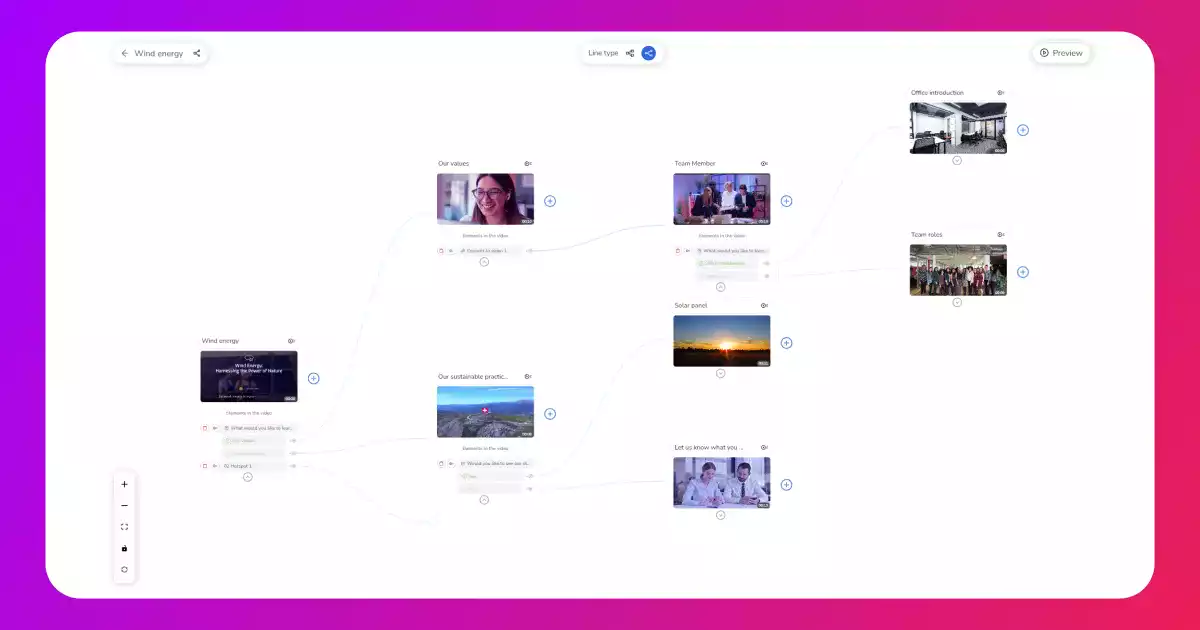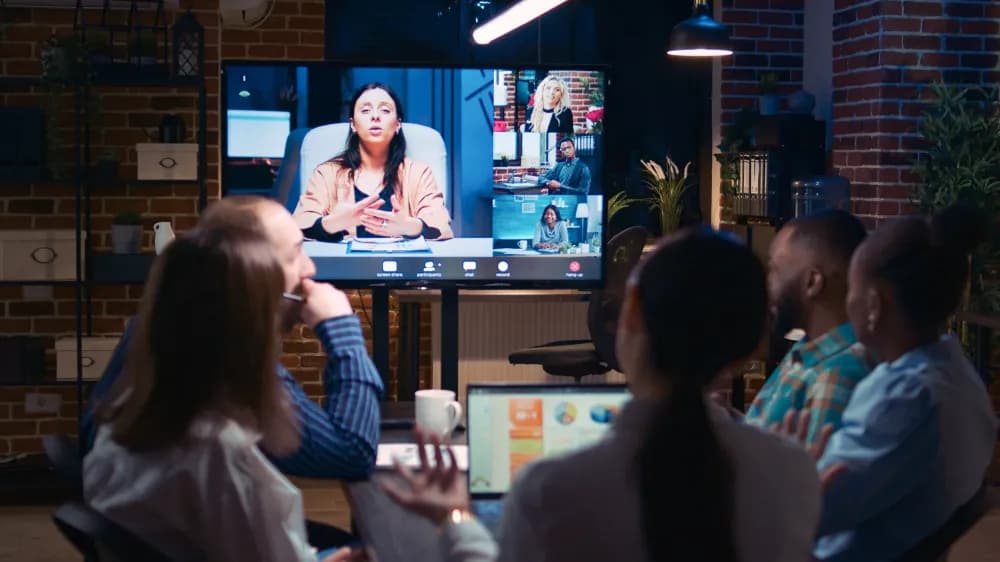The most practical ways to use interactive video help businesses sell products, deliver training, capture leads, and create personalised experiences. From branching product demos to shoppable campaigns and interactive quizzes, these approaches turn video into a tool for growth. In this guide, we explore 10 proven ways companies are applying interactive video today, and how platforms like Cinema8 make it simple to put them into action.
1. Use branching to create interactive product demos
Branching video is an interactive video format that allows viewers to choose their own path through content, making it one of the most versatile applications of interactive video. Instead of presenting the same information to everyone, you can build journeys that adapt to different needs. For example, a SaaS company might design a branching demo where prospects can select between “marketing automation features” or “reporting dashboards” depending on their role. In education, trainers use branching to replicate real-world scenarios, such as compliance decision-making or customer service simulations.
The advantage of branching is that it feels like a personalised conversation, not a static broadcast. By allowing the viewer to make decisions, brands create higher engagement and longer watch times. Cinema8’s branching editor lets marketers design these interactive flows without code, making it possible to map out customer journeys that reflect real buying behaviour. This turns a product video into a guided exploration that shortens the sales cycle and builds trust.

2. Add clickable hotspots to make products discoverable
Clickable hotspots and CTAs transform a standard video into an interactive shopping or learning experience by turning specific areas of the screen into clickable triggers. This is especially powerful in e-commerce, where viewers can click directly on items within a fashion video to view pricing, sizes, or colour options. A furniture retailer could allow viewers to click on a sofa to see available fabrics, while a tech company might showcase different features of a laptop.
Beyond retail, hotspots also work in training and education. A science video could highlight specific parts of a diagram with clickable definitions, while a cooking tutorial might include hotspots for ingredients that link to recipes or nutritional details. The strength of hotspots lies in their simplicity: they add interactivity without overwhelming the viewer. With Cinema8, businesses can add hotspots that link to checkout pages, forms, or resources, ensuring that viewers access relevant information at the right moment.
3. Showcase spaces and products with interactive 360° video
360° interactive video lets audiences explore a product or environment as if they were there. Instead of passively watching a single camera angle, viewers can rotate perspectives, zoom into details, and navigate spaces freely. Real estate agencies use 360° interactive video tours so buyers can walk through properties remotely, comparing room layouts and visualising how furniture would fit. Travel companies use it to let potential customers look around hotel rooms, beaches, or attractions before booking. Retailers apply multi-view interactive video to let shoppers inspect fabrics, textures, or design details that influence purchasing decisions.
This level of control gives viewers a deeper sense of presence, helping them evaluate options more thoroughly without requiring a physical visit. Businesses benefit by reducing the need for in-person showings, answering common pre-purchase questions earlier, and building stronger intent to buy. With Cinema8, companies can publish 360-degree interactive videos directly in the browser, making these experiences accessible across desktop and mobile without extra software.
4. Explain complex products and services with interactive video
Some products and services are too complex to explain in a single linear video. Interactive product explainers solves this by letting viewers explore features or topics at their own pace. A SaaS platform can create a branching walkthrough where prospects choose to dive into analytics, integrations, or pricing. Healthcare providers can build interactive explainers that let patients click on treatment options to see tailored information. Engineering firms often use it to simplify technical processes for stakeholders.
By giving viewers control, interactive video reduces overwhelm and speeds up decision-making. Instead of watching a generic overview, prospects and customers focus only on what matters to them, whether that’s a specific feature, a treatment pathway, or a technical workflow. With Cinema8, businesses can add clickable hotspots, branching menus, or layered explanations to turn a standard product demo into an interactive video that directly answers individual questions and removes barriers to purchase.
5. Turn video into a sales channel with shoppable interactive video
Shoppable interactive video lets customers buy products directly while watching. Fashion retailers tag clothing items in lookbook videos so viewers can add them to their basket instantly. Electronics brands showcase features with clickable product tags that lead straight to checkout. Beauty companies use interactive tutorials where viewers can select and buy the full set of products being demonstrated.
The impact is measurable: fewer drop-offs, higher conversion rates, and shorter purchase paths. When customers don’t have to leave the video to search for items, abandoned carts decrease and impulse purchases increase. With Cinema8, marketers can tag products, integrate with e-commerce systems, and connect checkout directly to shoppable video content, turning campaigns into active revenue channels, not just brand awareness plays.
6. Personalise training and surveys with adaptive interactive video quizzes
Adaptive quizzes inside interactive video adjust questions based on a viewer’s previous answers. A corporate trainer can build compliance modules that adapt to employee responses, focusing only on areas where they need improvement. A skincare brand can run a product finder quiz where follow-up questions shift according to each customer’s preferences. Education providers use adaptive testing to create learning journeys that suit individual progress levels.
The value is relevance and efficiency. Employees complete training faster, marketers capture more accurate customer data, and learners stay engaged because the content reflects their needs. Cinema8 allows businesses to embed adaptive quizzes, mix multiple-choice with free-text inputs, and integrate results into analytics dashboards, turning video into both a teaching tool and a data collection system.
7. Add booking and live tools with embedded interactive video widgets
Booking and participation tools make interactive video a direct channel for conversion. A consultancy can add a scheduling widget inside a service overview video, so prospects secure a meeting without leaving the content. Training providers embed calendars in onboarding videos to let learners reserve live sessions. Event organisers use live chat and polls inside promotional videos, turning viewers into active participants instead of passive spectators.
For businesses, the outcome is more bookings and stronger audience engagement at the exact point of interest. A prospect who schedules a demo mid-video is far less likely to drop off later. Attendees who ask questions or vote in real time stay invested in the session. With Cinema8, companies can embed calendars, maps, chat boxes, and forms directly into their videos, while automatically syncing all responses into CRMs. This ensures every booking, question, or interaction translates into a measurable lead or customer action.
8. Deliver personalised experiences with interactive video
Personalisation makes interactive video more relevant by tailoring it to the individual viewer. A bank can use data-driven video to show account options or mortgage rates based on a customer’s profile. An e-learning provider adapts lesson paths to each learner’s progress, keeping them engaged without repeating content they already know. Retailers use personalisation to display offers tied to location or real-time stock levels.
For businesses, the benefit is higher engagement and stronger conversion intent. When viewers feel that the content speaks directly to their situation, they watch longer and are more likely to act. With Cinema8, teams can connect CRM data, user behaviour, and prior interactions to deliver personalised interactive videos at scale. This transforms a one-size-fits-all message into thousands of individualised journeys—without adding manual work for the marketing team.
9. Drive interaction during live events with interactive video participation
Live interactive video turns an event into a two-way experience. A product launch can include polls where viewers vote on which feature to see next. Webinars can integrate real-time quizzes to reinforce key messages. Live streams often allow audiences to submit questions that hosts answer instantly, making the event feel more like a conversation than a broadcast.
This participation leads to stronger retention and better insights. Attendees stay longer when they feel involved, and the feedback they provide can guide sales or product strategy immediately. With Cinema8, businesses can embed polls, voting tools, and adaptive overlays into live streams, capturing input while the session is running. The result is an event that feels dynamic to the audience and delivers usable data back to the business.
10. Capture insights and leads with interactive video analytics
Every interaction inside an interactive video generates data that businesses can act on. A retailer learns which products attracted the most clicks, guiding future inventory and marketing. A B2B software provider collects qualified leads through in-video forms during product demos. Training organisations measure quiz performance to identify knowledge gaps and refine their programmes.
Unlike linear video, which only shows views and completion rates, interactive video reveals how people engage with specific elements. With Cinema8, companies access advanced video analytics tools like heatmaps, dashboards, and CRM integrations that connect these actions directly to business metrics. That means a product click becomes a sales opportunity, a form fill goes straight into the pipeline, and a training result informs curriculum updates. Interactive video becomes both a customer engagement tool and a measurable driver of growth.
What is the best way to start using interactive video?
Businesses are adopting interactive video experiences because it delivers results across the entire customer and learner journey. In e-commerce, shoppable campaigns turn video into a direct sales channel by removing steps between discovery and checkout. In B2B sales, branching demos give prospects control, so they focus only on the features that influence their buying decision. In corporate training, adaptive quizzes provide trainers with data on exactly where learners struggle, replacing one-size-fits-all modules with personalised guidance.
What connects all of these examples is the ability to act inside the video itself. Viewers book meetings, request information, answer questions, or make purchases without leaving the content. That immediacy reduces drop-offs and turns video into a channel that contributes directly to pipeline and revenue. Cinema8 brings these capabilities into one platform, combining branching editors, shoppable tags, live tools, and analytics dashboards. Every click, form, and booking syncs with your CRM, so video performance is tied to measurable outcomes. Book a demo to see why Cinema8 is the best interactive video platform to help your business put interactive video into action.
